OHIO — Wind, sun and water: The world has been moving toward using our natural resources for energy for more than a decade.
Ohio has the potential to be a leader in renewable energy.
About 20% of electricity in the United States comes from renewable sources, according to the U.S. Energy Information Administration. This is in contrast to Ohio, which gets around 3% of its energy from renewables. This puts the state in 40th place out of 50 states, according to American Clean Power.
Spectrum News traveled the state to check out some of Ohio’s largest wind, solar and hydroelectric power facilities.
First on the list: Brown County in northwest Ohio, which provides the source of wind power.
At Blue Creek Wind Farm in Van Wert and Paulding counties, 152 wind turbines dot the landscape and Shawn Haley oversees them all.

Haley is the wind farm’s plant manager. It’s an Avangrid Renewables Project that can produce about 304 Megawatts (MW) at a time. The project creates enough energy to provide power to about 76,000 Ohio homes, far more than the number of homes in the counties where this facility is located. The Ohio State University, First Energy Solutions and American Municipal Power purchase power from the wind farm.
“We are actually on site seven days a week in order to take care of these,” Haley said. "Basically, what we do is we capture the wind energy and turn it into electricity, and then put it on the grid to power homes and businesses.”
The project became fully operational in 2012 and spans nearly 80 square miles. Haley said the size of a wind farm varies on the area. Some wind farms have 30 to 60 turbines, while others have more than 100.
At Blue Creek Wind Farm, the turbines are more than 300 feet tall.
"We actually feel less wind on the ground than there is 100 meters up,” Haley said. “So that's exactly why these towers are a little bit taller than most. There is a different wind speed down here than there is up there."
This means a long climb for the farm’s technicians, but a stunning view of Ohio's landscape up top.
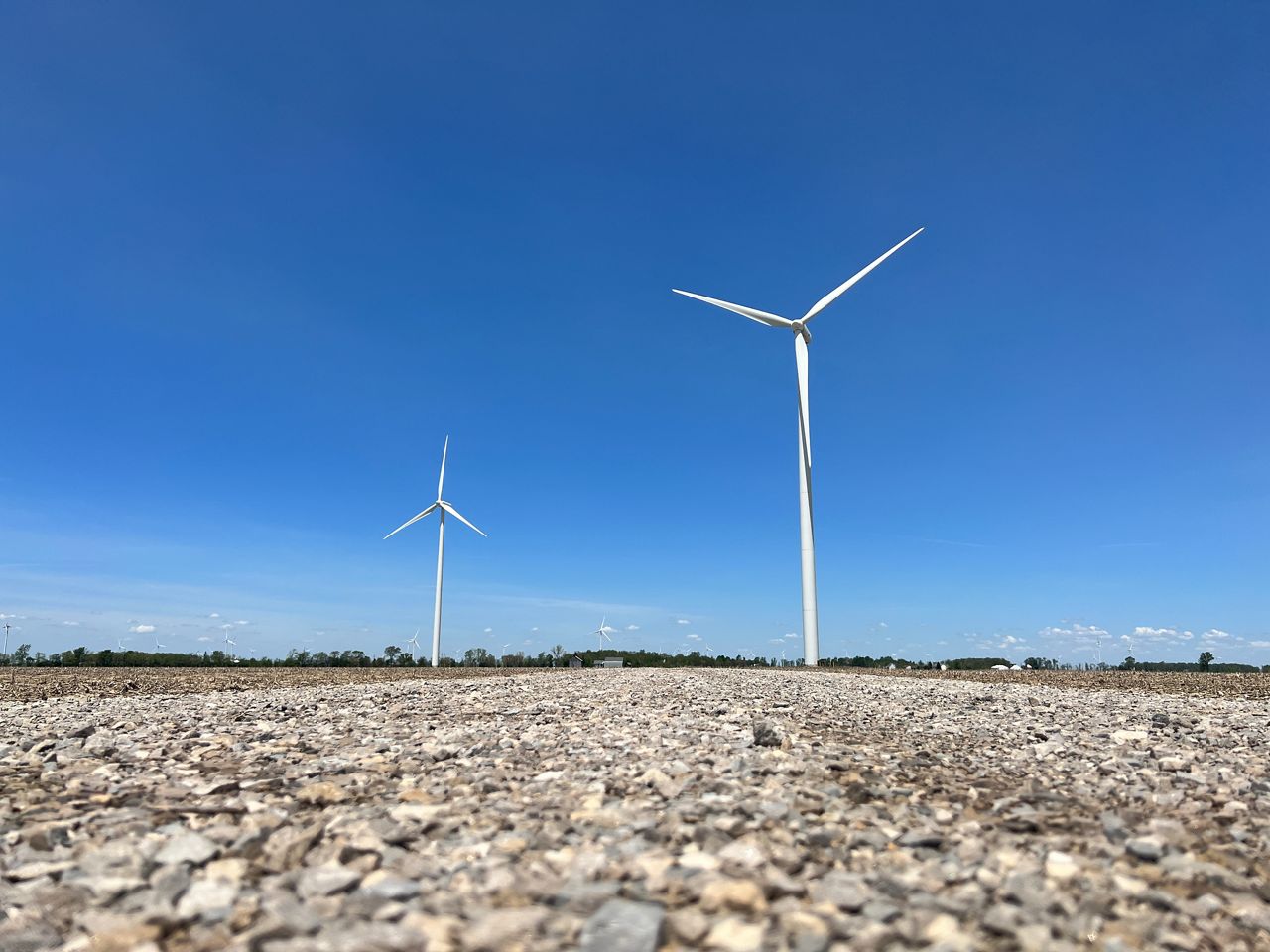
"The first time up, it was a little scary, but now it's just a normal day,” said Nick Sarrazine, a technician at Blue Creek Wind Farm. “It's pretty cool up tower, like, looking out over the farm fields and everything.”
Haley is from Chicago and moved to Ohio for this job.
"I think the best thing about wind power is it brings new people to the area,” he said. “It also brings new jobs to the area, and with that, we also are always giving back to the community and helping out."
Wind turbines do not release carbon into the atmosphere.
"Blue Creek Wind Farm alone, on average, on an annual basis, we save 1.6 billion pounds of carbon from going into the atmosphere, and that's equivalent to 116,000 cars being off the road,” Haley said.
According to the Ohio Power Siting Board, there are currently eight operational utility-scale wind farms in the state and three pending or in pre-construction.
Haley said he loves competition, and with the ever-increasing demand for energy, he thinks wind has potential to be a big player.
"With clean energy, you're not harming the environment,” he said. “The more we can do to help prevent harm to our environment, the better off we all are."
Ohio ranks first in the U.S. for wind-related manufacturing, yet wind energy itself only accounts for just more than 2% of the state’s energy production, according to U.S. Energy Information Administration.
Ohio's installed wind capacity is about 864 MW, according to the U.S. Energy Information Administration, falling behind neighboring states like Indiana, Michigan and Pennsylvania, leaving a lot of room to catch up.
For comparison, Indiana’s installed capacity is sitting at 2,968 MW and Pennsylvania is at 1,459 MW.
However, when looking at the potential installed capacity, Ohio could do more than either of those states with a possible capacity of 119,000 MW, according to the Office of Energy Efficiency & Renewable Energy.
That means, according to this data, Ohio is using less than 1% of its potential for installed wind capacity, roughly .73%. To contrast, Indiana is currently using roughly 2.5% of its potential and Pennsylvania is using 1.3%.
You pay your gas bill, and you pay to fill up your car, but you may not be aware of the other costs of fossil fuels.
Scientists have said the earth’s temperature has already risen by one degree celsius since the late 1800s, and the burning of fossil fuels is one of the primary reasons.
The clock is ticking to stop it.
Scientists warn the world needs to cut global carbon emissions in half by 2030. If steps aren't taken, the risk for even more extreme storms, heat waves and droughts increases. As sea levels continue to rise, the future of coastal communities remains at risk.
Rebecca Mellino is a climate and energy policy associate for The Nature Conservancy. In this interview, she explained the need to start moving away from fossil fuels and the untapped potential Ohio has for wind, solar and hydroelectric power.
A survey by Yale shows most Ohioans favor renewable energy. However, in July of last year, Gov. Mike DeWine signed Senate Bill 52 into law. The law gives local officials the authority to block the development of large-scale wind and solar projects in their area, holding those projects to a higher standard than fossil fuel projects.
A main criticism of these large wind and solar projects is the potential effect on natural habitats. Other opposition includes land use, property values, the obstruction of scenic views and potential health effects, although supporters of renewable energy say there is no evidence to support claims about potential health effects.
Mellino said environmental organizations like The Nature Conservancy are working with green energy developers to protect Ohio’s natural habitats.
Some lawmakers, like Rep. Shane Wilkin, are asking for all utility-scale solar projects to be halted. He said he's not necessarily for or against them, but he is calling for new rules or legislation to further protect the landscape and private property rights.
“When you don't have vegetative screening requirements, and you allow a six-foot chain link fence with three strands of barbed wire, that quite simply, it's just simply known here as prison fence,” said Wilkin. “That's what it looks like, a small-scale prison. So, until those are fixed, I don't think there should be another project approved in Ohio, and I know a lot of people in Ohio now are starting to fight them because of the eyesore that these are. Now, that said, I am a total defender of private property rights. But on things such as this power plant, there's gotta be reasonable setbacks, screening, these projects are taking up 1000s of acres, they go on for miles, and some of the things they're doing to the neighbors are simply not right.”
Critics of Senate Bill 52 say growth in renewable energy nationwide is going to continue, but Ohio will not see the benefits. They say it will discourage new businesses from coming to Ohio, potentially costing the state thousands of jobs.
Every day, the sun radiates an enormous amount of energy. That energy is used to grow the plants that provide the food and oxygen for life on Earth, and that energy can also be used to generate electricity.
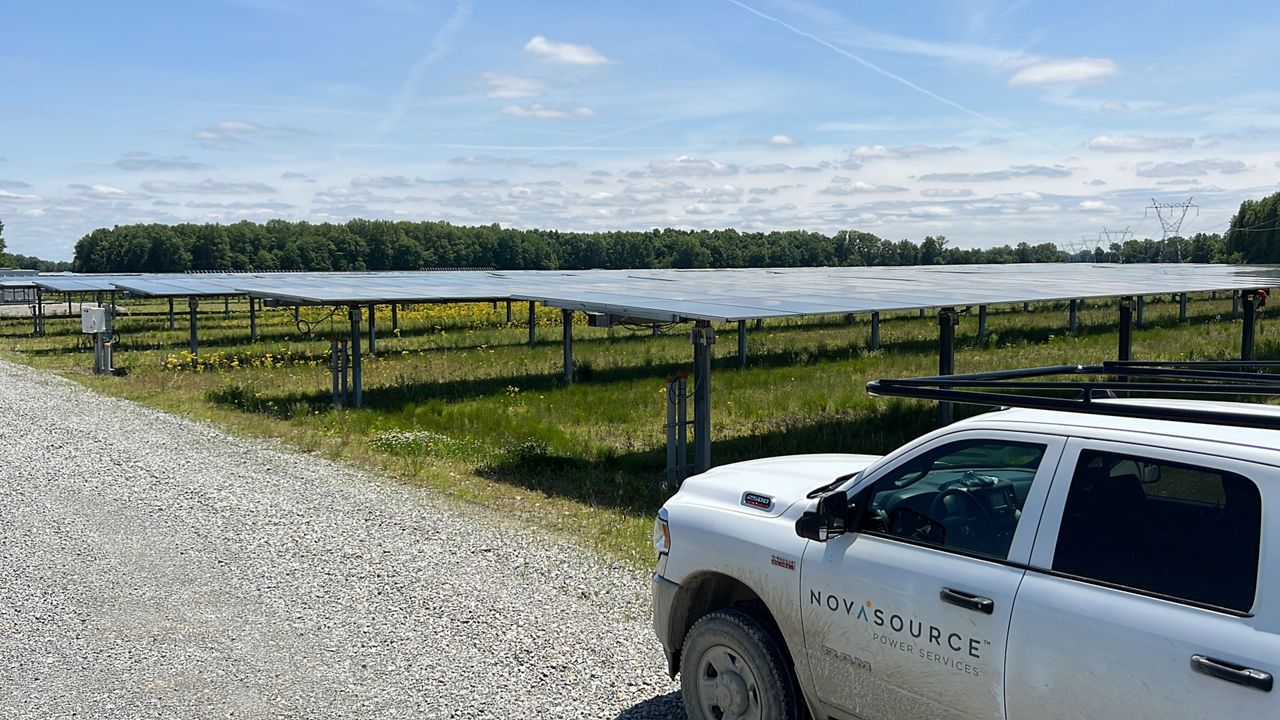
The Hillcrest Solar Power Project, now known as the Amazon Solar Farm Ohio Hillcrest, became fully operational in 2021. It’s currently the largest operational solar farm in the state. The project has more than 600,000 solar panels and can produce 200 MW at a time.
Amazon purchases all of that power.
“I think more and more companies are stepping up,” said Bill Behling, the director of development for Innergex, a global renewable energy company. “It's a matter of getting the projects up and running and getting, the key is finding, for solar, is finding relatively flat land and access to the to the grid, access to the transmission system. So in southern - southwestern Ohio, has a lot of both.”
More and more cities and corporations are setting sustainability commitments. Some have goals to reach net-zero carbon emissions.
“We see more and more companies, corporations asking for renewable, to purchase renewable power, not just here in Ohio, but across the country,” Behling said.
Many are aiming to power their operations with 100% renewable energy. Amazon is one of them, and Intel's proposed $20 billion semiconductor plant in Licking County is another. Amazon is currently the world's largest corporate buyer of renewable energy. A spokesperson for Amazon said the company has 310 projects across 19 countries and is on path to powering its operations with 100% renewable energy by 2025, five years ahead of its original 2030 target.
Amazon Solar Farm Ohio — Hillcrest is one of Amazon’s 18 utility-scale renewable energy projects in the state. The projects help supply clean energy for Amazon’s operations in the state and across the region, including its corporate offices, fulfillment centers and Amazon Web Services data centers.
“By signing long-term contracts, they’re then supporting the development," Behling said. "It allows us to get financing, it allows us to build the projects, they're supporting a credit worthy, you know, we're a great investment-grade company that can develop and own and operate these projects for the long term."
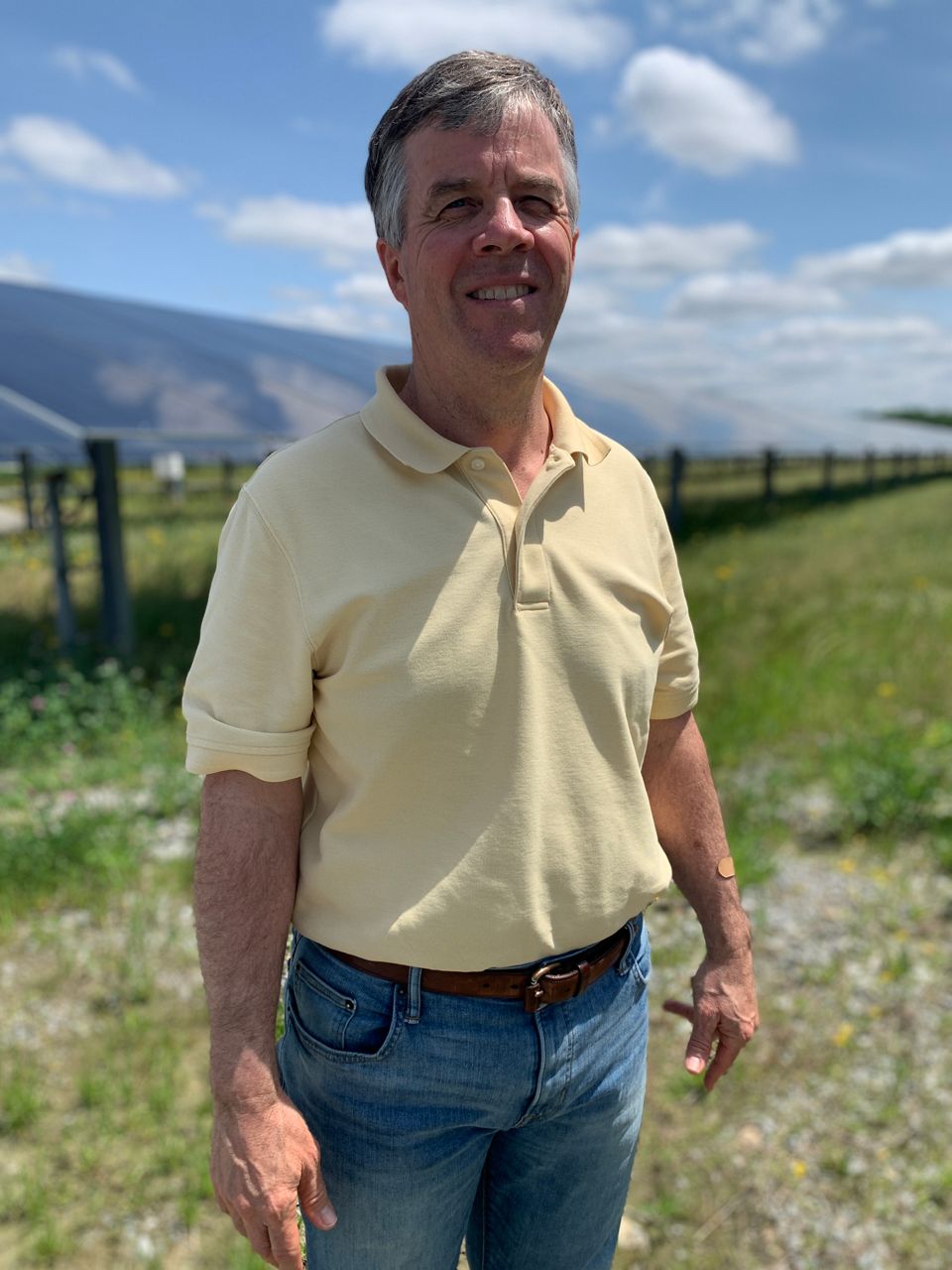
A recent report released by the Corporate Climate Responsibility Monitor, however, evaluated the net-zero pledges of 25 major companies and found the vast majority had “low” to “very low” integrity on these promises. The study found that many of these companies actually only committed to reducing their emissions by 40%, not 100%.
“We set out to uncover as many replicable good practices as possible, but we were frankly surprised and disappointed at the overall integrity of the companies’ claims” lead author Thomas Day said in a CCRM press release. “As pressure on companies to act on climate change rises, their ambitious-sounding headline claims all too often lack real substance, which can mislead both consumers and the regulators that are core to guiding their strategic direction. Even companies that are doing relatively well exaggerate their actions.”
According to the Ohio Power Siting Board, there are currently three operational utility-scale solar farms in the state but dozens more are in the pipeline.
“There's plenty of land available,” Behling said. “It's the access to that transmission system and the upgrades that may be needed to bring additional plants on.”
Behling said investing in and modernizing our transmission system will cost a pretty penny, but it will also create jobs, increase the grid’s efficiency, and lower costs for consumers. He thinks it's worth it so Ohio can reap the benefits of solar power.
“Solar offsets the carbon from a coal plant or a gas plant or any fossil fuel generation because this is carbon free,” he said. “It's emission free, there's no nitrous oxides, sulfur oxides, mercury emissions. There's no methane.”
Farmers and landowners can benefit, too. Farmers who can lease land for solar panels or wind turbines often welcome the chance to earn extra guaranteed yearly income, which can help get them out of a "bad" year caused by drought, floods, erratic weather and the ever-fluctuating costs of crops and livestock.
According to The Nature Conservancy, there are hundreds of thousands of acres of brownfields—defined by the EPA as a property, the expansion, redevelopment, or reuse of which may be complicated by the presence or potential presence of a hazardous substance, pollutant, or contaminant—and coal mine land in Ohio that can be used for renewable energy development without taking away from agriculture.
The Amazon Solar Farm Ohio — Hillcrest project is under a long-term agreement for 35 years. After that, it can either be re-powered or decommissioned and recycled. Until then, it will help power Amazon while coexisting with Ohio’s landscape.
“We're really trying to keep this as natural a setting as we can for the wildlife, for the birds, for the insects, pollinators,” Behling said. “We know how important that is. We want to coexist, and that's exactly what the whole point of renewable energy is, is that we can generate power, we can generate electricity, but we can also improve the environment and the habitat of the area as well.”
A lot of people think renewable energy will lead to job loss. Last year in Ohio, the clean energy sector grew to an all-time high of 112,000 jobs, even as Ohio’s employment dropped overall. In this interview, Spectrum News spoke with the executive director for the Great Lakes Energy Institute at Case Western Reserve University about the types of jobs renewables create.
The Ohio River is vast. It’s 981 miles long and flows through or borders six states. There are 20 dams on the Ohio River, but only about half use moving water to generate power.
Each day, huge hydro turbines use water from the Ohio River to spin a generator and produce electricity.
"We produce our power for 193,000 customers, mostly across the state of Ohio and a few other states,” said Scott Barta, assistant vice president of hydroelectric operations for American Municipal Power, also known as AMP. “Renewable power in our area is mainly coming from the hydro plant as opposed to the coal plant which is slightly upstream here. We all rely on water. They’re built on the river so they can use cooling water, we’re built on the river so we can get our power from the water.”

People have been harnessing the natural flow of water for thousands of years. Hydropower is actually one of the oldest sources of renewable energy.
It’s possible to trace hydropower back to ancient times, well before electricity was used. Think of water wheels or even ancient aqueducts. The Office of Energy Efficiency and Renewable Energy also mentions that Egyptians used water screws during irrigation back in the third century B.C.E.
Modern hydropower turbines, the office said, came about via Bernard Forest de Bélidor, a French engineer from the 1700s. While renewable energy may often seem cutting edge, these practices have been plied throughout our history.
The Willow Island Hydroelectric Plant is part of a three-plant project that, combined, puts out 200 MW and provides power to more than 200,000 customers in five states, according to AMP. In total, AMP owns and operates five hydropower plants on the Ohio River, including one joint venture.
"It's for the future,” said Pamela Sullivan, chief operating officer at AMP. "Hydro is more efficient. It's going to operate more hours out of the year than a wind or solar facility. It’s dispatchable, it helps to enable additional solar and wind because it helps back that up."
AMP uses multiple energy generation types and Sullivan said 25% of the power supplier’s energy currently comes from renewables.
She said they’re working to increase that number.
“It's very exciting,” Sullivan said. “I’m very proud of what our membership has done. This isn't, these were not developed because of a federal mandate or a state mandate. This is because communities wanting to do the right thing. From an environmental perspective, from a social perspective. Really, from a cost perspective, these are long term. This plant should operate another 70, 80 years."
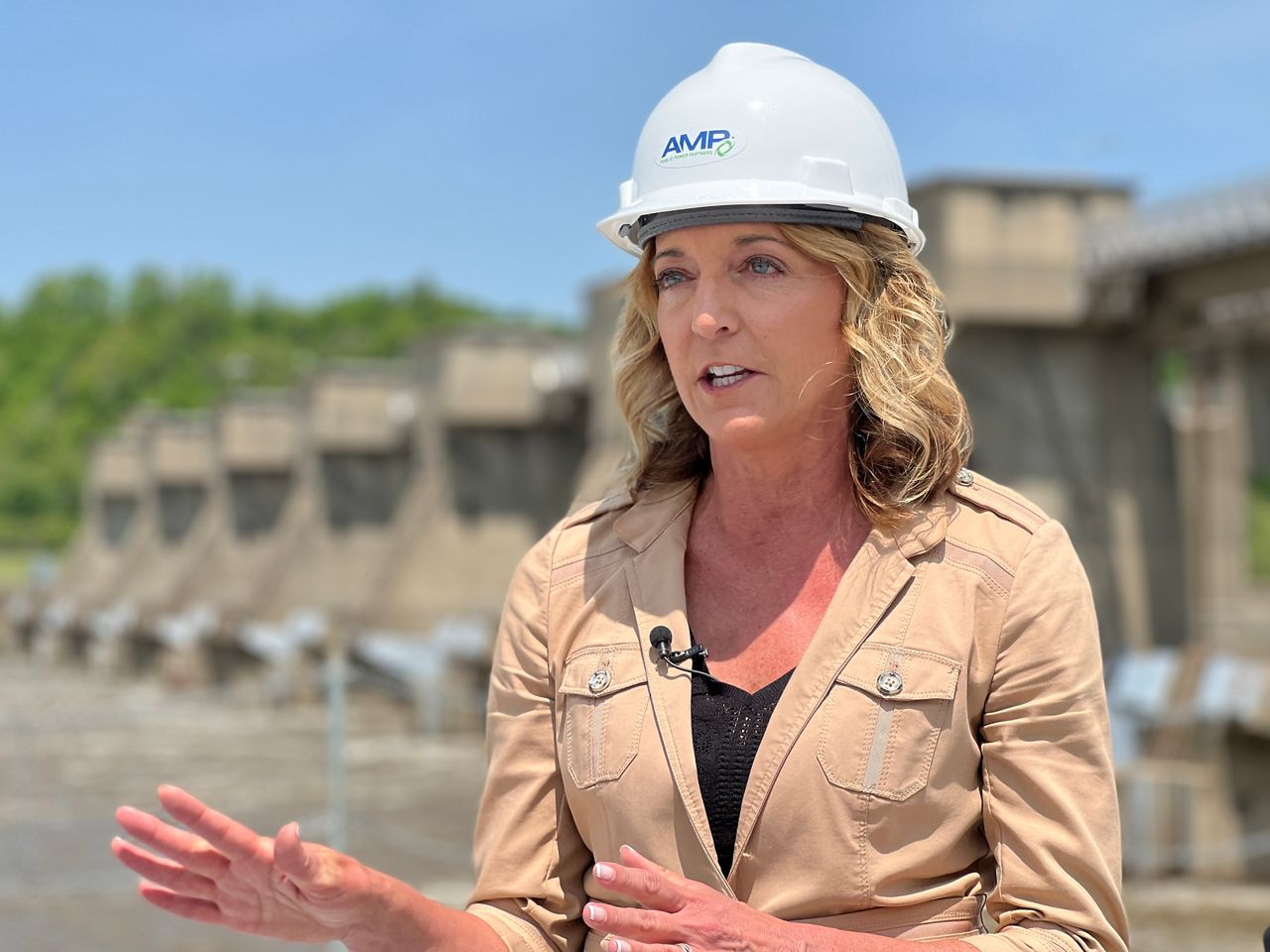
According to the Department of Energy, there are more than 90,000 dams in the U.S. and fewer than 2,300 of them produce power. That means about 97% of all the dams in the U.S. are currently not generating power.
Ohio has about 50 non-powered dams (NPDs) with potential to be powered, according to the National Hydropower Association.
A report from the U.S. Department of Energy found that hydropower facilities are “only a fraction of the infrastructure development that has taken place on the nation’s waterways.”
The report continues to note that adding power to already existing dams can save money on hydrodevelopment.
“Importantly, many of the monetary costs and environmental impacts of dam construction have already been incurred at NPDs, so adding power to the existing dam structure can often be achieved at lower cost, with less risk, and in a shorter timeframe than development requiring new dam construction,” the report said. “The abundance, cost, and environmental favorability of NPDs, combined with the reliability and predictability of hydropower, make these dams a highly attractive source for expanding the nation’s renewable energy supply.”
East of Columbus on the Muskingum River, there are 10 dams. There are plans for six of those dams to be built up to generate electricity.
One of the dams, Lock #9 Philo, is the oldest system of hand-operated locks in the United States.
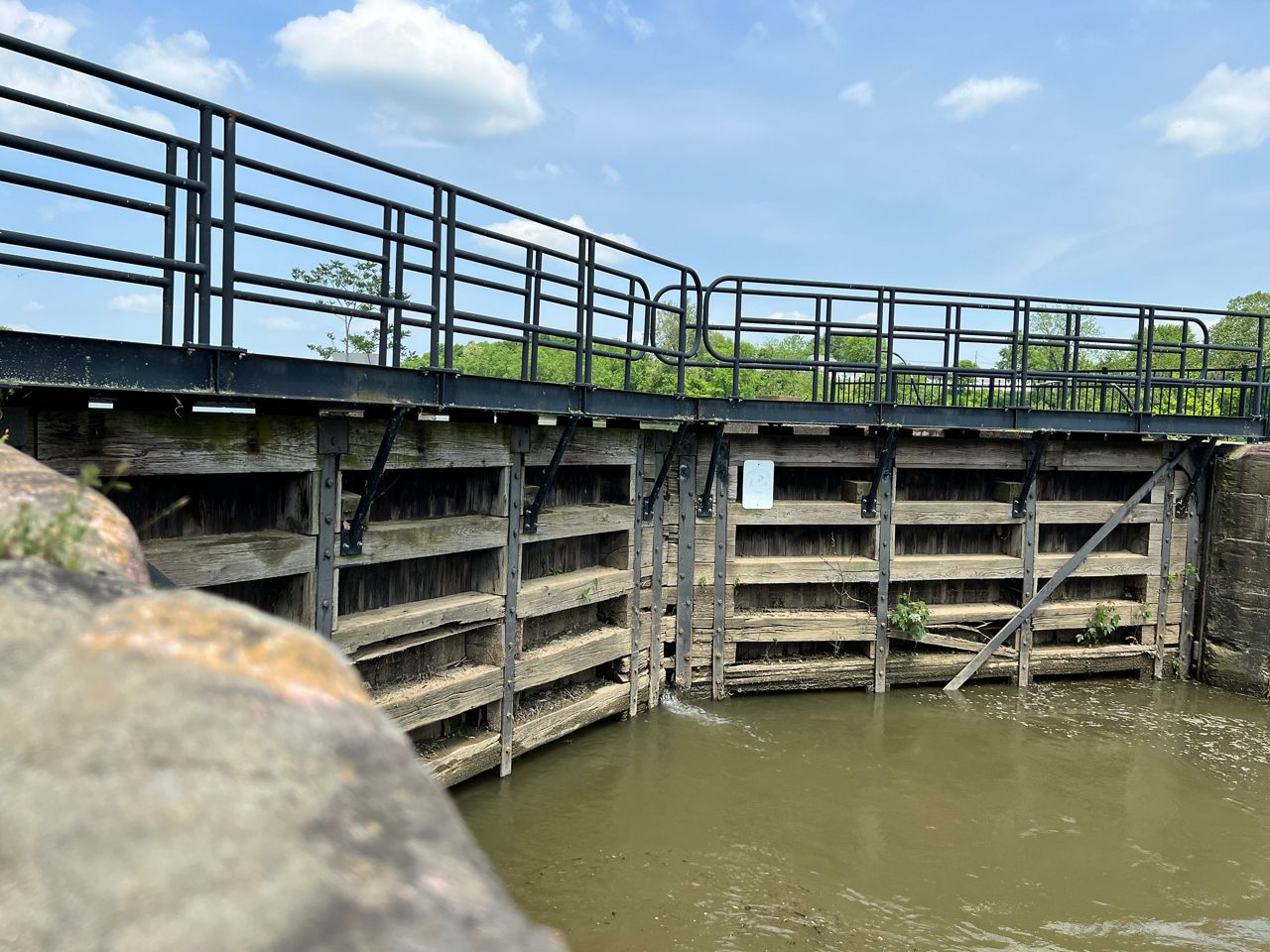
Rye Development, a leading U.S. hydropower company, has the Federal Energy Regulatory Commission (FERC) license to construct the projects on the Muskingum River.
"Of all the dams in the U.S., only 3% of them have power,” said Nate Sandvig, vice president of Rye Development. “So this is one of those opportunities where you can put hydropower turbines and have power for the existing structure that's already here with minimal impact."
The projects would total 23 MW, enough to power more than 11,000 homes each year. They wouldn’t take away from any of the history of the dams, only enhance the resource.
“The nice thing is you'll still have the recreational value, you'll still have the lock and dam, too,” Sandvig said. “I mean, they've been here for 185 years. So you'll continue to have this here. So you'll have recreation. You'll have the river and you're just looking at a small little powerhouse over there.”
The projects were proposed in 2016 and they’re now in need of a buyer for the power. Hydro projects do take a long time to get moving, but Sandvig said he is confident someone will purchase the power because hydropower is very affordable and reliable in terms of clean energy.
"Whether it's a corporate entity or a utility trying to meet their clean energy goals, or corporate goals, this would be one of those projects, like a wind project or a solar project, that they can, that they could buy power from and demonstrate their commitment to the local community or the state when it comes to clean energy goals,” Sandvig said.

Hydropower is the country's largest source of renewable energy, but is one of the least-used sources in Ohio. According to the U.S. Energy Information Administration, less than 1% of Ohio's power comes from hydro, leaving a lot of room for growth.
The numbers show that as the United States makes the transition from what’s been a fossil-fuel-powered economy to an electrified economy, Ohio is lagging behind.
As the race continues to significantly reduce carbon emissions worldwide, Ohio has an opportunity to help rescue, rebuild and renew our climate, not just for current generations, but for generations to come.
Renewable energy technology is evolving and we’re learning more each day. Spectrum News will continue to dive deeper into renewable energy, exploring the pros and cons, misconceptions and roadblocks to getting us to net-zero carbon emissions.
Cody Thompson contributed to this report.










